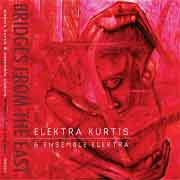
|
contents | world | |||||||||||||
| Elektra Kurtis Ensemble - Bridges From the East  Internationally acclaimed violinist, educator and composer Elektra Kurtis is inspired by living music as well as iconic composers like Bartok, Stravinsky, Bach, Thelonious Monk and other 20th century composers. She combines jazz with other ethnic forms. Her mission is to integrate in a natural way these musical traditions and styles as related throughout her life. Elektra's compositions use the melodies and rhythmic patterns of ethnic dances, relating them to modern improvised practices. She also employs chromaticism paired with middle eastern modality, ornaments, phrases and modulatory improvisations comparable to a Taxim. Her mathematical approach creates a synthesis of polyrhythmic counterpoint with layers of corresponding melody lines. The blues and bebop scales have a central place in her compositions. They are used as improvising formulas that alternate with the Arabic/Greek modes. Internationally acclaimed violinist, educator and composer Elektra Kurtis is inspired by living music as well as iconic composers like Bartok, Stravinsky, Bach, Thelonious Monk and other 20th century composers. She combines jazz with other ethnic forms. Her mission is to integrate in a natural way these musical traditions and styles as related throughout her life. Elektra's compositions use the melodies and rhythmic patterns of ethnic dances, relating them to modern improvised practices. She also employs chromaticism paired with middle eastern modality, ornaments, phrases and modulatory improvisations comparable to a Taxim. Her mathematical approach creates a synthesis of polyrhythmic counterpoint with layers of corresponding melody lines. The blues and bebop scales have a central place in her compositions. They are used as improvising formulas that alternate with the Arabic/Greek modes.Elektra Kurtis comes from a Greek family who were emigrants from Egypt to Poland. She learned her heritage growing up in Warsaw, Poland. Elektra took her earliest influences from avant-garde contemporary music created in the sixties and seventies, Bartok, Jazz recordings from the US and the folk music of Greece, Bulgaria, Africa and Tibet and blended it into her own language. Later, as a student of classical violin at the Sibelius Academy of Music in Helsinki, Finland, Elektra studied harmony and classical music forms, along with classical violin performance repertoire. Arriving in New York City which became her home, she performed with and observed the work of many jazz luminaries and contemporary composers like: Henry Threadgill, Steve Coleman, John Zorn, Lester Bowie, Leroy Jenkins, Billy Bang and others. While on tour with the Cuban bassist Cachao Lopez, Elektra learned the use of montunos in Cuban music. She studied Arabic Classical music with Simon Shaheen and played in his Near Eastern Ensemble. All these influences come together in Elektra's soul and compositions. She feels that her life's mission is to express the joy through the unification of these diverse cultures and styles and include her ethnic heritage, creating new contemporary jazz works and expanding the musical concepts. . View More Youtube Elektra Kurtis CD Description Track & Description 1. Triton is dedicated to the Greek sea god with the horn. He is introduced with a melody constructed using triton intervals in the opening theme when he enters. 2. Hasaposerviko is Part 1 of "Rhapsody in Greek, " a dance utilizing the flavor of Rebetiko in the first section followed by the original dance feel in the second. 3. Red Apple starts with a Polish folk theme arrangement. It develops into an improvisatory irregular groove in 5/4. 4. 334 is a chromatic, angular play on rhythms that make hidden 334 patterns. Each instrument can interchange the melodic line with each other. 5. Trebble Duet Nr.1 was inspired by Bartok, Henry Threadgill and Steve Coleman and includes improvisations on eastern modes and rhythms. 6. Zeibekiko is Part 2 of "Rhapsody in Greek." A jazzy dance with a Greek traditional 9/8 Zeibekiko rhythmic pattern, the track mixes Arabic, Greek and New York flavors. 7. August 7was written for Kurtis' Mother on the day she lost her fight with cancer. It is about her Mother's journey on the Greek mythological Styx River, the divide between Earth and the Underworld. Her boat moves through the water and disappears from sight. 8. Eastern Caravan was inspired by the music of the European Gypsies and Argentinian tango. 9. Like Rocks, a composition which evolved over time, reveals the realization of what is truly significant in life. The music follows the melody of the spoken words. 10. Kalamatianos, Part 3 of "Rhapsody in Greek, " is written in a 7/8 rhythmic pattern and references Arabic and Greek musical styles. 11. Trebble Duet Nr. 2is Part 2 of 3 duets. 12. Krakus is based on themes inspired by the Polish mountains – Podhale. The driving bass line compliments the changing moods of the track with clarinet and violin solos. 13. East West was inspired by the Greek art song masters of the 60s and 70s, Mikis Theodorakis and Manos Hadjidakis. Their long melodic phrases and folk dance rhythms create an off center, contemporary Zeibekiko dance. 14. Bossa for Kitsa was written by Kurtis' for her dear Aunt Kitsa on the day she got the news about her accidental passing in Athens, Greece. Aunt Kitsa was a lively, energetic, and resourceful lady, and a fabulous cook. The Bossa feel fits her very well. 15. Trebble Duet Nr.3. Part 3 of 3 duets. 16. Summer's End, the closer was written at the end of a hot New York City summer and the funky track uses irregular meter and several driving bass lines to make it's point. Player and instrument: Elektra Kurtis, violin Curtis Stewart, violin Lefteris Bournias, clarinet Bradley Jones, bass Reggie Nicholson, drums write your comments about the article :: © 2016 Jazz News :: home page |